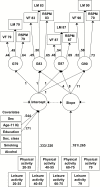Lifecourse Activity Participation From Early, Mid, and Later Adulthood as Determinants of Cognitive Aging: The Lothian Birth Cohort 1921
- PMID: 27974473
- PMCID: PMC5156497
- DOI: 10.1093/geronb/gbw124
Lifecourse Activity Participation From Early, Mid, and Later Adulthood as Determinants of Cognitive Aging: The Lothian Birth Cohort 1921
Abstract
Objectives: To examine potential sensitive periods for activity participation across adulthood to reduce cognitive decline and to determine whether associations persist after accounting for the lifetime stability of cognitive ability.
Method: The Lothian Birth Cohort 1921 is a longitudinal study of cognitive aging. Participants were born in 1921 and most completed a mental ability test at the age of 11 years. Cognitive assessments were completed at mean ages 79 (N = 550), 83 (N = 321), 87 (N = 235), and 90 years (N = 129). Participants provided retrospective details of their activity participation for young (20-35 years), mid (40-55 years), and later adulthood (60-75 years), and contemporaneously at age 79.
Results: Associations between activity and the level of, and change in, cognitive ability in old age were examined with latent growth curve models. Accounting for demographics and childhood cognitive ability, engagement in leisure activities in midlife was positively associated with cognitive ability level (path coefficient = .32), whereas higher physical activity in later adulthood was associated with less cognitive decline (.27).
Discussion: The findings support a lifecourse approach in identifying determinants of cognitive aging; leisure and physical activity during different periods of adulthood may enhance cognitive abilities or reduce decline.
Keywords: Differential preservation; Leisure activity; Longitudinal; Physical activity; Preserved differentiation; Retrospective.
© The Author 2016. Published by Oxford University Press on behalf of The Gerontological Society of America.
Figures

References
-
- Andel R., Silverstein M., Kåreholt I. (2015). The role of midlife occupational complexity and leisure activity in late-life cognition. The Journals of Gerontology, Series B: Psychological Sciences and Social Sciences, 70, 314–321. doi:10.1093/geronb/gbu110 - PubMed
-
- Anstey K., & Christensen H (2000). Education, activity, health, blood pressure and Apolipoprotein E as predictors of cognitive change in old age: A review. Gerontology, 46, 163–177. doi:10.1159/000022153 - PubMed
-
- Arbuckle J. L. (1996). Full information estimation in the presence of incomplete data. In Marcoulides G. A., Schumacker R. E. (Eds.), Advanced structural equation modeling: Issues and techniques (pp. 243–277). Mahwah, NJ: Lawrence Erlbaum Associates.
-
- Baer L. H. Tabri N. Blair M. Bye D. Li K. Z., & Pushkar D (2013). Longitudinal associations of need for cognition, cognitive activity, and depressive symptomatology with cognitive function in recent retirees. The Journals of Gerontology, Series B: Psychological Sciences and Social Sciences, 68, 655–664. doi:10.1093/geronb/gbs112 - PubMed
-
- Bielak A. A. M. (2010). How can we not ‘lose it’ if we still don’t understand how to ‘use it’? Unanswered questions about the influence of activity participation on cognitive performance in older age—A mini-review. Gerontology, 56, 507–519. doi:10.1159/000264918 - PubMed
MeSH terms
Grants and funding
LinkOut - more resources
Full Text Sources
Other Literature Sources

